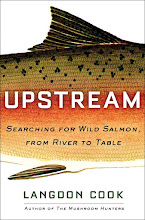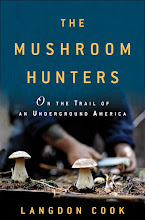In my neck of the woods it's fiddlehead time right now. In fact, those at sea level have already unscrolled their lovely coiled shoots, but several hundred feet higher in the lower foothills of the Cascades the fiddleheads are just now awaking to spring (even though they got hailed on the other day) and stretching their arms beside gurgling rivulets of runoff.
These are the young shoots of the lady fern, Athyrium felix-femina. East of the Rockies the fiddlehead of choice is the ostrich fern, Matteuccia struthiopteris.
The best way to forage a fiddlehead patch is to identify the adult ferns in summer, when their fronds are easily recognized, then go back in spring and pick the newly emerged fiddleheads. A good patch will be chockablock with ferns. In my region these patches are most often found in moist mixed woodlands, usually near water. Swamps, streamsides, estuaries, and other riparian areas offer suitable habitat. Sometimes disturbed ground can provide an opening for fiddlehead patches. I know of a long stretch of gently rolling terrain beneath powerlines where the trees have been cleared that is now home to lady ferns as far as the eye can see.
Once the fronds are fully leafed out they become toxic. Move up in elevation.
My own experience with lady fern fiddleheads is that their taste varies widely. Some are quite bitter, others are more buttery and rounded in flavor, like a cross between artichoke and asparagus. I haven't figured out why. Perhaps the flavor is influenced by soil ph or other environmental conditions. In any event, preparation can be tailored to suit taste. With a particularly bitter batch, I'll temper with butter, lemon juice, and salt in a simple fiddlehead pasta tossed with parmesan. Milder batches accompany meats or fish as a side dish. A fiddlehead frittata is an excellent way to enjoy them and I've also pickled fiddleheads. But my new preferred way to prepare fiddleheads is...
...Sichuan style. One of my favorite Sichuanese dishes—a signature preparation known to even casual admirers of the spicy cuisine from southwestern China—is Dry-fried String Beans. Using fiddleheads in place of string beans, I made a similar dish the other night to accompany Kung Pao Chicken. And it turned out even better than expected.
Prep the fiddleheads carefully. Soak in water a few minutes before rubbing off the papery sheaf with your fingers. Blanche in salted boiling water for a minute, then thoroughly dry with paper towels. Even a tiny amount of moisture can pop and sizzle dangerously in a hot wok.
1 lb fiddleheads, cleaned
1/4 lb ground pork
1/3 cup peanut oil
1 tbsp garlic, diced
1 tbsp ginger, diced
10 dried red chili peppers
1/4 tsp Sichuan peppercorns, ground
2 tbsp Sichuan preserved vegetable, chopped
3 scallion bulbs, chopped
2 tsp Chinese rice wine (or dry sherry)
1 tbsp chili bean sauce
1/2 tsp sesame oil
1/2 tsp dark soy sauce
1 tsp sugar
1/4 tsp salt, or more to taste
1. Combine rice wine, chili bean sauce, sesame oil, dark soy sauce, and sugar in small bowl to make sauce. Set aside.
2. Blanche fiddleheads for 1 minute in boiling, well-salted water. Remove and dry thoroughly with paper towels.
3. Heat oil in wok until nearly smoking, then add fiddleheads and stir-fry for a few minutes until beginning to blister. Remove to paper towels.
4. Pour off all but a tablespoon of oil and return to heat. Add garlic, ginger, chopped scallion bulbs, red chili peppers, preserved vegetable, and Sichuan peppercorns. Cook a minute until fragrant, then add ground pork. Stir-fry together until pork is browned. Return fiddleheads to wok, add reserved sauce, and stir-fry another minute to coat.
5. Sprinkle with salt and serve.























